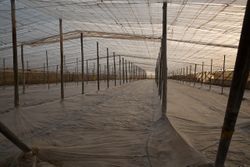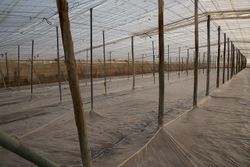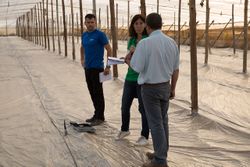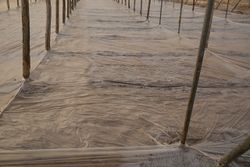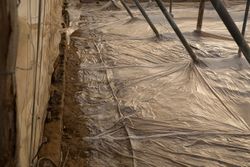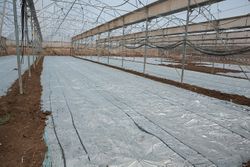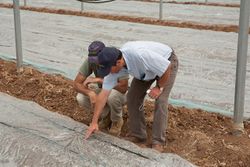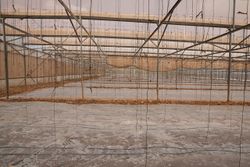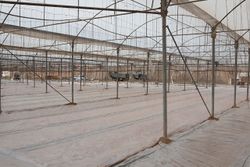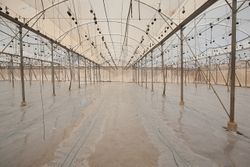Difference between revisions of "Ag Robot"
MaiKangWei (talk | contribs) (→Israel) |
MaiKangWei (talk | contribs) |
||
| Line 1: | Line 1: | ||
| + | A sponsor is facing a situation in which it would be useful to have a remotely-controlled robot to drive up and down rows in a greenhouse and make cuts into a plastic tarp covering the soil. I expect that this would be a fairly simple robot with tank drive, pneumatic wheels (8" probably okay), a rotating knife assembly to do the cutting and a camera to facilitate driving. I don't guess pneumatics are needed. The sponsor would subsidize the cost of the robot, which I expect would not exceed $5,000 (x-shipping). | ||
| + | |||
| + | I've discussed this with the sponsor, and they are enthusiastic about the project. | ||
| + | |||
| + | I think that this is a good summer project for us as well (although I wish we didn't have so much on our plate already). I think it's also a really good E.I. story line. | ||
| + | |||
| + | As a not-FIRST robot project, we have some additional flexibility with components. | ||
| + | |||
| + | I've put together some assumptions and questions for this project (attached) to help in setting clear objectives and specifications. Any editions or additions to this list would be welcome. | ||
| + | |||
| + | ==Starting Assumptions== | ||
| + | |||
| + | *Robot will be remote-controlled (not autonomous), wheeled vehicle | ||
| + | *Driver will have video stream to guide driving | ||
| + | *12 VDC battery power supply – no voltage >24 VDC | ||
| + | *Wireless communications - No tether | ||
| + | *Not XP | ||
| + | *A switched Main Circuit Breaker will turn robot on and off. The switch will be easily accessed, but protected to avoid accidental tripping. | ||
| + | *An easily-observed light will indicate that the robot is powered | ||
| + | *The Main Breaker will supply a Power Distribution Breakout which will power all power users on the robot via individually fused (circuit breaker) terminals | ||
| + | *All wires will be copper | ||
| + | **6 AWG for 120 A protected circuit | ||
| + | **12 AWG for 31-40 A protected circuit | ||
| + | **14 AWG for 21-30 A protected circuit | ||
| + | **18 AWG for 6-20 A protected circuit | ||
| + | **22 AWG for ≤ 5A protected circuit | ||
| + | **28 AWG for Signal Level Circuits ≤ 1A | ||
| + | *Constant polarity non-signal wires will be typically color coded red for positive, black for negative or common | ||
| + | *Electronics will be shielded from dripping water; not against immersion | ||
| + | *Battery removable/replaceable for recharging | ||
| + | *Battery to remain in overturned robot | ||
| + | *Battery indicator on control panel | ||
| + | |||
| + | |||
==Mazarrón, Murcia, Spain== | ==Mazarrón, Murcia, Spain== | ||
Revision as of 13:15, 2 June 2018
A sponsor is facing a situation in which it would be useful to have a remotely-controlled robot to drive up and down rows in a greenhouse and make cuts into a plastic tarp covering the soil. I expect that this would be a fairly simple robot with tank drive, pneumatic wheels (8" probably okay), a rotating knife assembly to do the cutting and a camera to facilitate driving. I don't guess pneumatics are needed. The sponsor would subsidize the cost of the robot, which I expect would not exceed $5,000 (x-shipping).
I've discussed this with the sponsor, and they are enthusiastic about the project.
I think that this is a good summer project for us as well (although I wish we didn't have so much on our plate already). I think it's also a really good E.I. story line.
As a not-FIRST robot project, we have some additional flexibility with components.
I've put together some assumptions and questions for this project (attached) to help in setting clear objectives and specifications. Any editions or additions to this list would be welcome.
Starting Assumptions
- Robot will be remote-controlled (not autonomous), wheeled vehicle
- Driver will have video stream to guide driving
- 12 VDC battery power supply – no voltage >24 VDC
- Wireless communications - No tether
- Not XP
- A switched Main Circuit Breaker will turn robot on and off. The switch will be easily accessed, but protected to avoid accidental tripping.
- An easily-observed light will indicate that the robot is powered
- The Main Breaker will supply a Power Distribution Breakout which will power all power users on the robot via individually fused (circuit breaker) terminals
- All wires will be copper
- 6 AWG for 120 A protected circuit
- 12 AWG for 31-40 A protected circuit
- 14 AWG for 21-30 A protected circuit
- 18 AWG for 6-20 A protected circuit
- 22 AWG for ≤ 5A protected circuit
- 28 AWG for Signal Level Circuits ≤ 1A
- Constant polarity non-signal wires will be typically color coded red for positive, black for negative or common
- Electronics will be shielded from dripping water; not against immersion
- Battery removable/replaceable for recharging
- Battery to remain in overturned robot
- Battery indicator on control panel
Mazarrón, Murcia, Spain
The Mazarrón application is a little weird for a couple of reasons. First, the tarp and driplines are perpendicular to each other. Parallel is normal. Second, the joining of adjacent tarp sections is raised and stapled. Normal is glued and/or buried.
Israel
More typical application.
